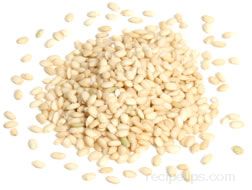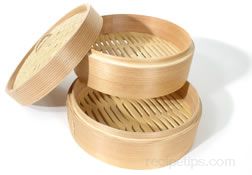Steaming Rice with a Bamboo Steamer | Steaming Rice with an Electric Steamer
|
 Steaming is a technique for cooking rice that is very popular in Asian countries. It produces perfectly cooked rice, but the method can be very time consuming. It is often a preferred cooking method for glutinous or sticky rice, because steaming reduces some of the natural stickiness of the rice. When sticky rice is cooked with the boiling or absorption methods, the rice tends to stick together, forming a large mass. It can be difficult to eat as a side dish when it is in this form. Steaming is a technique for cooking rice that is very popular in Asian countries. It produces perfectly cooked rice, but the method can be very time consuming. It is often a preferred cooking method for glutinous or sticky rice, because steaming reduces some of the natural stickiness of the rice. When sticky rice is cooked with the boiling or absorption methods, the rice tends to stick together, forming a large mass. It can be difficult to eat as a side dish when it is in this form.
There are several methods of steaming rice based on techniques developed in various areas of the world. Nearly all the methods require the rice to be washed first in order to remove some of the starch so that the rice will be less sticky when it is cooked. It is also beneficial to soak the rice or cook it briefly in boiling water before steaming, because the steaming method alone is often not adequate for cooking the rice to the desired doneness. |
Steaming Rice with a Bamboo Steamer
|
 One method for steaming rice that is popular (especially in Asia) and is easy to do (although it is time consuming) is with the use of a bamboo steamer. Use the following instructions for steaming rice in this manner. One method for steaming rice that is popular (especially in Asia) and is easy to do (although it is time consuming) is with the use of a bamboo steamer. Use the following instructions for steaming rice in this manner.
- Rinse 1½ to 2 cups of sticky rice in cold water and then soak the rice in cold water for several hours.
- After the soaking period, drain the rice.
- Line a bamboo basket with a damp steaming cloth.
- Place the presoaked and drained sticky rice into the lined basket and position another cloth on top of the rice.
- Place the lid on the basket and fold the excess cloth back and drape it over the top of the lid.
- Insert the basket of rice into a large shallow pan containing boiling water. A wok is a very suitable cooking vessel. The level of the water should be no higher than a half-inch on the outside of the bamboo steamer.
- Cook for about 30 minutes. As the water in the pan evaporates during the steaming process, additional water should be added to maintain the proper level. Unlike the absorption method, rice that is steamed should be checked often to make sure it doesn't become too dry; therefore, remove the lid periodically and check the rice, but re-cover the rice as soon as possible.
- When the rice has cook to the required doneness, fluff it with a fork prior to serving.
|
Steaming Rice with an Electric Steamer
|

Another method for steaming rice is to use an appliance that is specifically designed to cook rice. An electric rice steamer shuts off automatically when the water has been absorbed into the rice. The rice can even be kept warm in the appliance for several hours without becoming sticky and clumped together, which can happen readily when this attempted on the stovetop. An electric rice steamer provides an almost foolproof method for producing evenly cooked rice every time. It is a handy tool for people who want to include more rice in their diets but have been reluctant to proceed because of their unsuccessful attempts to cook rice via traditional methods.
|
| Note: Do not add salt during the cooking time when using the steaming method because salt will lengthen the cooking time. Salt can be added to taste after the rice is cooked. |
| Note: Some varieties of white rice can be quite tasteless on their own, especially when boiled or steamed (unless an aromatic variety, such as basmati or jasmine is used), so they are often used as a base for other flavorful dishes, such as stir-fries, steamed vegetables, or stews. If served simply as a side dish, many cooks prefer to enhance the flavor of the rice with herbs, spices, oils, or other flavorings. Brown rice, which contains some or all of the bran, is more flavorful than white rice, and it has a chewier texture. | |

 Steaming is a technique for cooking rice that is very popular in Asian countries. It produces perfectly cooked rice, but the method can be very time consuming. It is often a preferred cooking method for glutinous or sticky rice, because steaming reduces some of the natural stickiness of the rice. When sticky rice is cooked with the boiling or absorption methods, the rice tends to stick together, forming a large mass. It can be difficult to eat as a side dish when it is in this form.
Steaming is a technique for cooking rice that is very popular in Asian countries. It produces perfectly cooked rice, but the method can be very time consuming. It is often a preferred cooking method for glutinous or sticky rice, because steaming reduces some of the natural stickiness of the rice. When sticky rice is cooked with the boiling or absorption methods, the rice tends to stick together, forming a large mass. It can be difficult to eat as a side dish when it is in this form. One method for steaming rice that is popular (especially in Asia) and is easy to do (although it is time consuming) is with the use of a bamboo steamer. Use the following instructions for steaming rice in this manner.
One method for steaming rice that is popular (especially in Asia) and is easy to do (although it is time consuming) is with the use of a bamboo steamer. Use the following instructions for steaming rice in this manner.